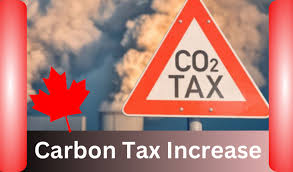Carbon tax increase 2024: History, Meaning of Carbon tax, Causes, Canada Carbon tax increase 2024, what this could mean to taxpayers, Recent News And Everything To Know

The national price on pollution has risen by $15 per tonne as of April 1, 2024, affecting consumers, small- and medium-sized businesses. Let’s delve into what this increase means for you:
What Is a Carbon Tax?
A carbon tax is a policy mechanism aimed at reducing greenhouse gas emissions by placing a price on carbon. It encourages individuals, businesses, and industries to adopt cleaner energy sources and also reduce their carbon footprint. The basic idea is simple: the more carbon you emit, the more you pay.
History of Carbon Tax in Canada
Canada has been at the forefront of implementing carbon pricing policies. Here’s a brief overview:
- 2019: The federal government introduced the Greenhouse Gas Pollution Pricing Act. which also established a national carbon pricing system.
- Also 2020: The carbon price was set at $30 per tonne of CO2 equivalent.
- 2024: The carbon tax increased by $15 per tonne, bringing it to $45 per tonne.
Who pays the carbon price?
-
- Canada has two carbon pricing programs:
- Big Industry: Companies pay a share of their actual emissions.
- Consumer Carbon Levy: Applied to fossil fuel purchases by individuals, small- and medium-sized businesses, First Nations. And public-sector operations (such as hospitals, universities, schools, and municipalities).
- The consumer levy applies in every province and also territory except British Columbia, Quebec, and Northwest Territories. B.C. and Northwest Territories have their own similar carbon charges for consumers, while Quebec uses a cap-and-trade system considered equivalent to the federal price in terms of emissions.
- Canada has two carbon pricing programs:
What is the consumer carbon levy applied to?
-
- The fuel charge is added to more than 20 different fuel sources that produce greenhouse gas emissions when burned for energy. These include gasoline, propane, diesel, and natural gas.
- The additional cost varies based on the greenhouse gases produced by each fuel. For instance:
- Gasoline: The carbon price on a liter of gasoline is now 17.6 cents, up 3.3 cents from before.
- Diesel: The price for a liter of diesel also includes 21.39 cents in carbon price, up from 17.38 cents.
- Propane: The price for propane now includes 12.38 cents per liter in carbon price, up from 10.08 cents.
Impact on Fuel Prices:
-
-
- Gasoline: The carbon price on a liter of gasoline has increased from $65 per tonne to $80. This translates to approximately 17.6 cents per liter (up 3.3 cents from before). Filling a 50-liter tank will now cost about $8.80 in carbon price, approximately $1.65 more than before.
- Diesel: The price for a liter of diesel now includes 21.39 cents in carbon price (up from 17.38 cents).
- Also Propane: Propane prices include 12.38 cents per liter in carbon price (up from 10.08 cents).
- Natural Gas: On average, Canadian households use about 2,280 cubic meters of natural gas annually for heating. At $80 per tonne, the carbon price adds 15.3 cents per cubic meter (up from 12.4 cents previously). This results in an annual carbon price bill for natural gas of about $347 on average.
-
Remember, these changes aim to address environmental concerns. But they also impact household budgets. Stay informed and adapt to the evolving landscape of carbon pricing!

